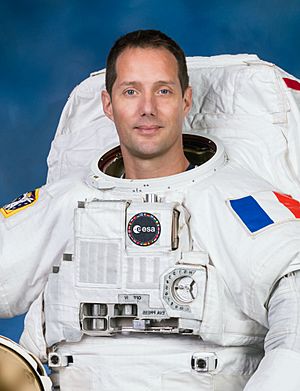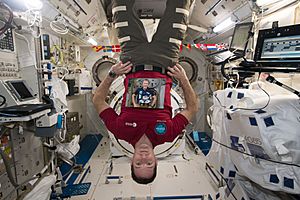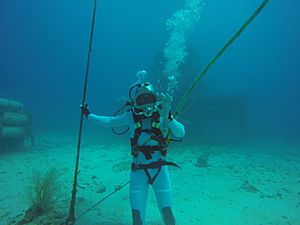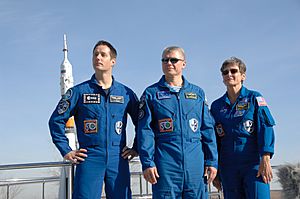Thomas Pesquet facts for kids
Quick facts for kids
Thomas Pesquet
|
|
|---|---|

Official portrait, 2020
|
|
| Born |
Thomas Gautier Pesquet
27 February 1978 |
| Status | Active |
| Nationality | |
| Occupation | |
| Space career | |
| ESA astronaut | |
|
Time in space
|
396 days 11 hours 34 minutes |
| Selection | 2009 ESA Group |
|
Total EVAs
|
6 |
|
Total EVA time
|
39 hours, 54 minutes |
| Missions | Soyuz MS-03 (Expedition 50/51) SpaceX Crew-2 (Expedition 65/66) |
|
Mission insignia
|
   |
Thomas Pesquet (born February 27, 1978) is a famous French astronaut. He is also an engineer and a pilot. The European Space Agency (ESA) chose him as an astronaut candidate in May 2009. He finished his basic training in November 2010.
Thomas Pesquet has flown to the International Space Station (ISS) twice. His first trip was from November 2016 to June 2017. He was part of Expedition 50 and Expedition 51. He went back to space in April 2021. This second trip was on a SpaceX Crew Dragon spacecraft. He stayed on the ISS for another six months.
Contents
About Thomas Pesquet
Thomas Pesquet was born in Rouen, France. He has an older brother. Thomas is very active and enjoys many sports. He has a black belt in judo. He also likes basketball, jogging, swimming, and squash.
He loves outdoor adventures. He enjoys mountain biking, kite surfing, sailing, skiing, and mountaineering. He is also skilled in scuba diving and parachuting. His other hobbies include traveling, playing the saxophone, and reading.
His Education
Thomas Pesquet finished high school in Rouen, France, in 1996.
In 2001, he earned a master's degree. He studied space systems and how space vehicles work. He got this degree from a special school in Toulouse, France. He also studied in Canada for a year.
Later, in 2006, Thomas graduated from the Air France flight school. This training allowed him to become an airline pilot. He can speak French, English, Spanish, Chinese, German, and Russian.
His Career Journey
Before becoming an astronaut, Thomas Pesquet worked as an engineer. From 2001, he worked on spacecraft in Spain. He helped with missions that used satellites to observe Earth.
Between 2002 and 2004, he worked for the French space agency, CNES. He was a research engineer. He studied how space missions could work on their own. He also helped plan future European space technology.
In 2004, he was chosen for Air France's pilot training. He became a commercial pilot for Air France in 2006. He flew the Airbus A320 plane. He has flown for over 2000 hours. He also taught other pilots how to fly the A320.
In 2018, Thomas Pesquet learned to fly the Airbus A310. He also became a pilot for special Zero-G flights. These flights create a feeling of weightlessness.
Becoming an ESA Astronaut
Thomas Pesquet was chosen as an astronaut by the European Space Agency (ESA) in May 2009. He started with ESA in September 2009. He finished his basic astronaut training in November 2010. He is the youngest astronaut in the European Astronaut Corps. He was the last of his group to fly to space.
Thomas also took part in special training missions. In 2014, he lived in an underwater laboratory called Aquarius. This was part of the NEEMO 18 mission. It helped him prepare for space. He also explored caves in 2011 and took part in another mission called SEATEST II in 2013. These experiences helped him learn about exploration.
In 2014, ESA chose Thomas for a six-month mission to the International Space Station. This mission began in November 2016.
First Space Mission: Expedition 50/51
Thomas Pesquet launched into space on November 17, 2016. He flew on the Soyuz MS-03 spacecraft from Baikonur Cosmodrome. He spent six months on the International Space Station. He was part of Expedition 50 and Expedition 51. He arrived at the ISS on November 19, 2016. He was the first French astronaut to visit the ISS since 2008. His mission was called Proxima.
The Proxima mission included 50 science experiments. These experiments were for ESA and CNES. The mission was named after Proxima Centauri. This is a tradition for French astronauts to name missions after stars. The "X" in the mission logo showed that Thomas was the tenth French astronaut. It also stood for the unknown. A 13-year-old boy from France chose the name Proxima in a competition.
Thomas Pesquet did his first spacewalk on January 13, 2017. He worked with astronaut Shane Kimbrough. They prepared the ISS to replace its batteries. The spacewalk lasted almost 6 hours.

On March 23, 2017, Thomas did his second spacewalk with Shane Kimbrough. They prepared a part of the station called PMA-3. This part would be moved to a new location. It would then be used for future spacecraft to dock. They also fixed a robotic arm and checked a radiator. Radiators help cool the space station. This spacewalk lasted over 6 hours.
On June 2, 2017, Thomas Pesquet returned to Earth. He landed in the Soyuz MS-03 spacecraft. His first mission in space lasted 196 days.
Second Space Mission: Expedition 65/66
On March 11, 2020, ESA announced that Thomas Pesquet would return to the ISS. This second mission started in the second half of 2021. He became the first European astronaut to launch on an American Commercial Crew Vehicle. On July 28, 2020, he was officially assigned to the SpaceX Crew-2 mission. He was a mission specialist. He flew with NASA astronauts Shane Kimbrough and Megan McArthur, and JAXA astronaut Akihiko Hoshide. Thomas named his second mission Alpha. This name also follows the French tradition of naming missions after stars.
The Crew Dragon Endeavour spacecraft launched on April 23, 2021. It docked with the International Space Station on April 24. Once on board, they joined ISS Expedition 65.
During this mission, Thomas Pesquet performed four spacewalks. He did the first three spacewalks with Shane Kimbrough in June. They installed new solar arrays on the station. For his fourth spacewalk, he set a new European record. He became the European astronaut with the most total hours spent spacewalking. He had spent 39 hours and 54 minutes outside the ISS.
On October 4, 2021, Thomas Pesquet became the commander of the ISS. He was the first French astronaut to command the space station. He handed over command on November 6, 2021.
The Crew-2 mission landed in the Gulf of Mexico on November 9, 2021. Thomas Pesquet had spent 199 days in space on this mission.
Goodwill Ambassador
On April 12, 2021, Thomas Pesquet became a Goodwill Ambassador. He works for the Food and Agriculture Organization of the United Nations.
At the closing ceremony of the 2020 Summer Olympics, Thomas Pesquet played the French national anthem on his saxophone. He played it while he was aboard the International Space Station. This was part of the ceremony to introduce Paris as the host of the 2024 Summer Olympics.
Artistic Work
Thomas Pesquet wanted to share his love for space. He wrote a book about his life called "Ma vie sans gravité" (My life without gravity). He also appeared as himself in two movies: Proxima (2019) and Hawa (2022).
See also
 In Spanish: Thomas Pesquet para niños
In Spanish: Thomas Pesquet para niños
- French space program




